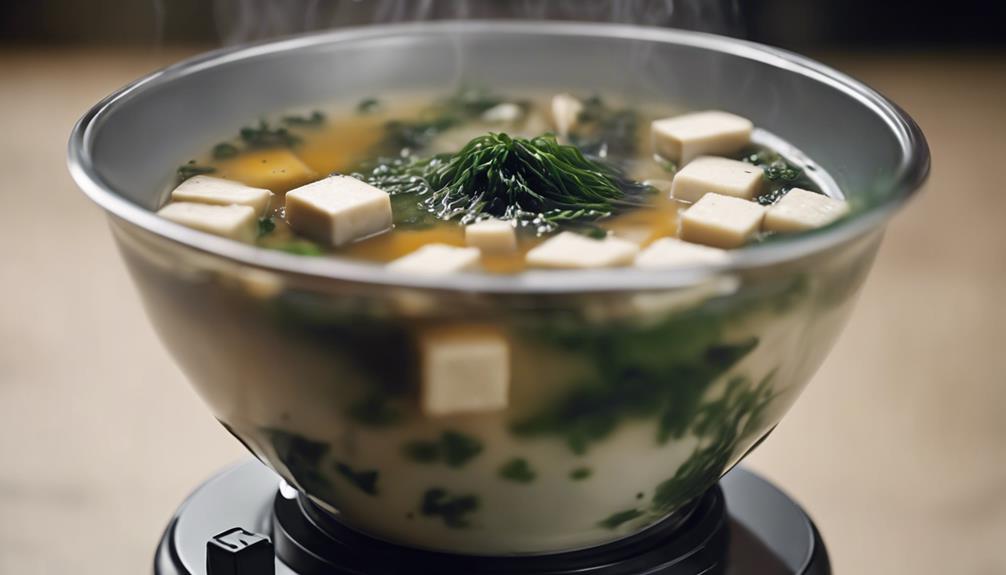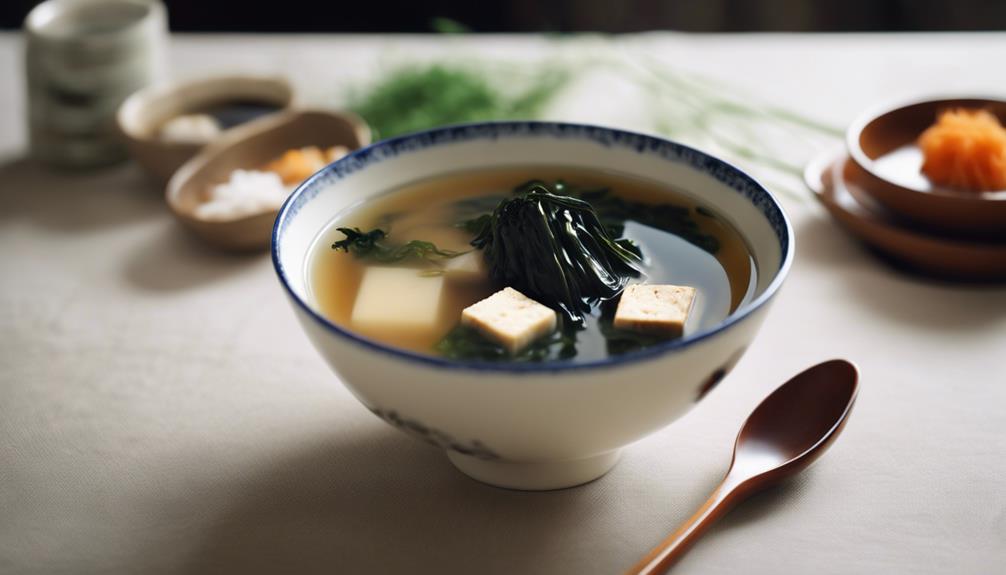Sous Vide Miso Soup With Seaweed and Tofu: a Light Breakfast Start
For a light breakfast that's both flavorful and nutritious, try Sous Vide Miso Soup with seaweed and tofu. This dish blends umami tastes with the health benefits of seaweed and tofu for a satisfying start to your day. The sous vide method guarantees consistent and delicious results, making it an easy and comforting morning option. Enjoy the harmony of traditional Japanese ingredients like miso paste, seaweed, and tofu in this warming bowl of goodness. Discover how this dish can kickstart your day with a burst of flavor and nourishment.
What You Will Learn Here
- Sous Vide Miso Soup offers umami taste, tender tofu, and seaweed flavors.
- Provides a comforting and light breakfast option.
- Ensures consistent and flavorful outcomes.
- Satisfies taste buds with a nourishing start to the day.
- Perfect for those seeking a satisfying, healthy meal.
Origins of Miso Soup

Miso soup has a rich history that dates back centuries, originating in Japan.
Traditional ingredients like miso paste, seaweed, and tofu are commonly used to create this flavorful dish.
The cultural significance of miso soup extends beyond its taste, symbolizing comfort, health, and tradition in Japanese cuisine.
Miso Soup History
Throughout Japanese culinary history, the origins of miso soup can be traced back to traditional cooking methods and cultural practices. Miso soup is a staple in Japanese cuisine, known for its rich umami flavor and comforting warmth. The key to miso soup lies in the fermentation techniques used to create miso paste, a blend of soybeans, salt, and koji mold. This paste is then mixed with dashi, a broth made from kombu (seaweed) and bonito flakes, to form the base of the soup.
Historically, miso soup was a popular dish among Japanese peasants and samurais due to the easy availability of ingredients like miso paste and seaweed. Over time, miso soup became a symbol of Japanese culinary tradition and was incorporated into daily meals as a source of nourishment and comfort.
The simplicity of its ingredients combined with the complex flavors produced through fermentation techniques has made miso soup a beloved part of Japanese culture, reflecting the harmony between nature and culinary artistry.
Traditional Ingredients Used
The origins of miso soup can be attributed to the traditional ingredients utilized in its preparation. Miso soup is known for its fermented goodness, combining the umami-rich flavors of miso paste with a delicate balance of seaweed and tofu.
Seaweed, a staple in Japanese cuisine, adds a touch of brininess and a wealth of nutrients to miso soup. It brings a unique oceanic flavor and a satisfying texture to the broth.
Tofu, on the other hand, contributes a creamy contrast to the soup, absorbing the savory miso flavors while providing a source of plant-based protein.
The harmonious blend of these ingredients creates a comforting and nourishing dish that has been enjoyed for centuries in Japan. Each sip of miso soup with seaweed and tofu combinations offers a taste of tradition and a glimpse into the culinary heritage of the East.
Cultural Significance
Revealing the cultural origins of miso soup sheds light on its profound significance in Japanese culinary heritage. Miso soup holds a special place in Japanese cultural customs, often enjoyed as a staple dish in households, restaurants, and even during traditional ceremonies.
Dating back centuries, miso soup has been cherished for its rich umami flavor and its association with warmth and comfort. The preparation of miso soup reflects a harmonious balance of flavors, textures, and colors, symbolizing the interconnectedness of nature and the seasons.
Beyond its cultural customs, miso soup offers a myriad of dietary benefits. Made from fermented soybean paste, miso is rich in probiotics and antioxidants, supporting gut health and overall well-being. The addition of seaweed and tofu in miso soup adds essential minerals and proteins, making it a nourishing and wholesome dish.
Key Miso Soup Components
What're the vital components that make up a delicious bowl of miso soup?
Traditional preparation of miso soup involves combining a few key ingredients that not only contribute to its distinct flavor but also offer various health benefits. Here are three components that play a pivotal role in crafting a satisfying bowl of miso soup:
- Miso Paste:
The heart of miso soup, this fermented soybean paste adds a rich umami flavor and depth to the broth. Miso isn't only delicious but also contains probiotics that promote gut health, strengthens the immune system, and aids digestion.
- Dashi Broth:
This savory broth, typically made from kombu (seaweed) and bonito flakes (dried fish flakes), forms the base of miso soup. Dashi is low in calories, high in essential minerals, and adds a satisfyingly savory undertone to the soup.
- Tofu and Vegetables:
Tofu provides a source of plant-based protein, while vegetables like seaweed, green onions, and mushrooms enhance the nutritional profile of the soup with vitamins, minerals, and antioxidants. These components contribute to a well-rounded and nourishing bowl of miso soup.
Tasty Miso Soup Variations

When it comes to tasty miso soup variations, the Savory Miso Tofu Delight stands out as a flavorful choice.
The combination of miso paste, tofu, and seaweed creates a rich and satisfying broth that's both hearty and delicious.
Adding some green onions or a sprinkle of sesame seeds can elevate this variation even further, making it a go-to option for a comforting meal.
Savory Miso Tofu Delight
For a comforting twist on traditional miso soup, consider adding savory tofu to create a delightful and hearty variation. When exploring new ways to elevate your miso soup experience, incorporating tofu can bring a satisfying depth of flavor and texture.
Here are three reasons why this savory miso tofu delight is a must-try:
- Tofu Textures: The addition of tofu introduces a contrast of textures to your miso soup, with its soft yet slightly chewy consistency complementing the broth's smoothness.
- Miso Umami: Tofu acts as a perfect canvas to soak up the rich umami flavors of the miso broth, enhancing the overall taste profile of the dish.
- Hearty and Filling: With tofu's protein-packed goodness, this variation of miso soup becomes a more substantial and filling meal, perfect for starting your day on a nourishing note.
Miso Soup Flavor Enhancers
When looking to enhance the flavor of your miso soup, consider the following key points.
To start, the umami-rich miso paste will provide a deep and savory taste to your soup.
Next, adding seaweed can introduce a briny essence that complements the miso beautifully.
Umami-Rich Miso Paste
To enhance the umami flavor of your miso soup, consider using a high-quality miso paste rich in depth and complexity. Miso paste, a traditional Japanese condiment made from fermented soybeans, is a key ingredient in creating the signature savory taste of miso soup.
When choosing a miso paste for your soup, opt for varieties that have been aged longer for a more robust flavor profile. Look for labels that indicate a blend of soybeans and possibly rice or barley, as these can add layers of taste to your dish.
The fermentation process of miso paste not only enhances its umami richness but also contributes to its probiotic properties, which can be beneficial for gut health. Miso paste comes in different shades ranging from light to dark, with darker varieties typically offering a more intense and complex flavor.
Experimenting with various types of miso paste can help you discover your preferred balance of saltiness, sweetness, and earthy undertones in your miso soup.
Seaweed: a Briny Addition
Consider incorporating seaweed into your miso soup as a revitalizing addition that enhances the overall flavor profile of the dish. Seaweed offers numerous benefits, including being rich in minerals like iodine, calcium, and iron.
Its unique umami taste complements the savory notes of miso paste, creating a harmonious flavor pairing that elevates the soup's taste.
When selecting seaweed for your miso soup, opt for varieties like Wakame or Kombu, which are commonly used in Japanese cuisine for their mild taste and tender texture when rehydrated. These seaweeds not only contribute to the soup's flavor but also add a subtle oceanic essence that enhances the overall dining experience.
To incorporate seaweed into your miso soup, simply soak the dried seaweed in water until it softens, then add it to the soup during the final stages of cooking. This allows the seaweed to infuse its revitalizing essence into the broth, enriching every spoonful with a hint of the sea.
Tofu for Added Protein
Enhance the protein content and texture of your miso soup by incorporating tofu as a flavorful addition. Tofu, a soy-based protein, is a versatile ingredient that not only boosts the nutritional value of your soup but also adds a creamy consistency that complements the umami flavors of miso.
Tofu offers numerous benefits, including being a rich source of plant-based protein, making it an excellent option for vegetarians and vegans looking to increase their protein intake. Additionally, tofu is low in calories and contains essential amino acids, making it a healthy choice for a balanced diet.
When adding tofu to your miso soup, consider recipes that involve marinating the tofu in soy sauce or other seasonings to enhance its taste before incorporating it into the soup. Cubed or silken tofu varieties work well in miso soup, providing different textures to suit your preferences.
Experiment with different tofu recipes to find the perfect combination that elevates your miso soup to a satisfying and protein-packed meal option.
Final Thoughts

To wrap up, reflecting on the overall experience of preparing and enjoying this Sous Vide Miso Soup with Seaweed and Tofu reveals the delightful harmony of flavors and textures that this dish offers.
The subtle umami taste from the miso, the tender tofu, and the earthy seaweed combine beautifully to create a comforting and light breakfast option.
As you ponder on the culinary benefits, consider how this dish not only satisfies your taste buds but also provides a nourishing start to your day.
The simplicity of the sous vide method enhances the infusion of flavors, ensuring a consistent and flavorful outcome every time you prepare this soup.
Frequently Asked Questions
Can I Use Any Type of Miso Paste for This Recipe?
You can choose different miso paste varieties to alter flavors in your dish. Lighter misos offer milder taste, while darker ones are more intense. For tofu in miso soup, silken tofu works best due to its delicate texture.
How Long Can I Store Leftover Miso Soup in the Fridge?
Store leftover miso soup in the fridge properly for up to 3 days. Check for any changes in taste before reheating. If it smells off or looks different, discard it to avoid spoiling your meal. Enjoy your soup!
Is It Necessary to Use a Vacuum Sealer for Sous Vide Cooking?
When cooking sous vide, a vacuum sealer debate arises. While it's not necessary, vacuum sealing enhances proper storage. Alternatives like water displacement bags work too. Benefits of vacuum sealing include better flavor preservation and improved cooking results.
Can I Substitute Seaweed With Other Ingredients in This Recipe?
You can swap seaweed for spinach or bok choy in the recipe. These alternatives offer different flavor profiles and texture variations. Traditional substitutes like mushrooms or sliced carrots can also enhance the dish's taste and appeal.
What Are Some Common Mistakes to Avoid When Making Miso Soup?
When making miso soup, maintain proper miso ratios for balanced flavor. Avoid cooking miso too long to preserve its beneficial enzymes. Remember, a well-crafted miso soup can be a comforting and nourishing dish for those you serve.
Conclusion
To sum up, sous vide miso soup with seaweed and tofu is a light and flavorful breakfast option that offers a unique twist on a traditional Japanese dish.
By utilizing the sous vide method, you can achieve a perfectly cooked and infused soup that's both satisfying and nutritious.
Experimenting with various ingredients and flavors can assist you in personalizing your miso soup to your preference, making it a versatile and enjoyable meal to kick off your day.











